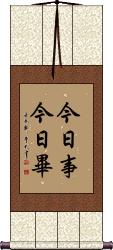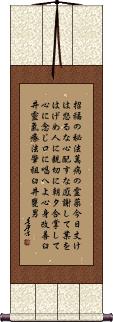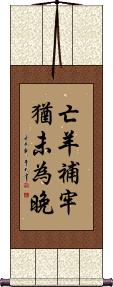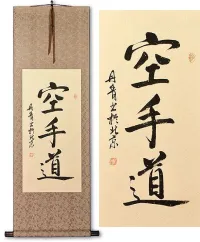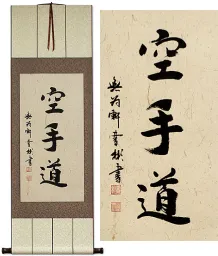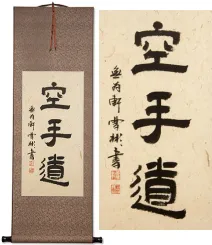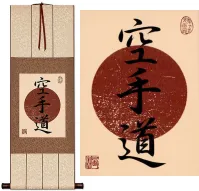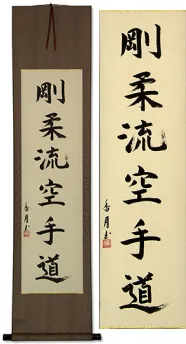Many custom options...
And formats...

Not what you want?
Try other similar-meaning words, fewer words, or just one word.
Do It Today in Chinese / Japanese...
Buy a Do It Today calligraphy wall scroll here!
Personalize your custom “Do It Today” project by clicking the button next to your favorite “Do It Today” title below...
1. Never put off until tomorrow what you can do today
3. The Five Principles of Reiki
4. Reiki Precepts by Usui Mikao
5. Hapkido
Never put off until tomorrow what you can do today
Live For The Day
活在今天 is not an eastern concept, so it does not translate into a phrase that seems natural on a wall scroll.
However, if this is your philosophy, the characters shown here do capture your idea of living for today or living in the moment. 活在今天 says “Live in today,” and they are grammatically correct in Chinese.
Note: This kind of makes sense in Korean Hanja but the grammar is Chinese, so it’s not that natural in Korean.
The Five Principles of Reiki
Reiki Gokai
These are the five principles of Reiki.
They translate into English as...
At least for today:
Do not be angry,
Do not worry,
Be grateful,
Work with diligence,
Be kind to people.
Note: Because this selection contains some special Japanese Hiragana characters, it should be written by a Japanese calligrapher.
Reiki Precepts by Usui Mikao (Alternate)
Alternate Version
靈氣療法肇祖臼井甕男先生遺訓招福の秘法萬病の霊薬今日丈けは心配すな感謝して業を励げめ人に親切に is an alternate version of the precepts or tenets of Reiki by Usui Mikao.
It is impossible to be sure which version or versions were actually written by Usui Mikao. This is the less common of the three versions that you might see in the wild.
Here is a breakdown of the characters and a rough translation:
靈氣 療法 肇祖 臼井甕男。
Reiki therapy founder Mikao Usui
先生 遺訓。
Teacher's testament
招福の秘法, 萬病の霊薬。
Invite blessings of [the] secret method, 10,000 illnesses of spiritual medicine.
今日丈けは: 怒るな, 心配すな, 感謝して, 業をはげめ, 人に親切に。
At least for today: Do not be angry, do not worry, be grateful, work with diligence, [and] be kind to people.
Note: Because this selection contains some special Japanese Hiragana characters, it should be written by a Japanese calligrapher.
Reiki Precepts by Usui Mikao
These are the precepts of Reiki that are attributed to Usui Mikao.
Here is a breakdown of the characters and a rough translation:
招福の秘法, 萬病の霊薬。
Invite blessings of [the] secret method, 10,000 illnesses of spiritual medicine.
今日丈けは: 怒るな, 心配すな, 感謝して, 業をはげめ, 人に親切に。
At least for today: Do not be angry, do not worry, be grateful, work with diligence, and be kind to people.
朝夕合掌して, 心に念じ, 口に唱へよ, 心身改善。
Morning [and] evening perform gassho (join hands), [with your] heart/mind in silent prayer, [with your] mouth chant, [thusly] mind [and] body [will] reform/improve.
臼井靈氣療法! -肇祖, 臼井甕男。
Usui Reiki Ryōhō! -Founder, Usui Mikao.
The middle portion of this is often titled, “The Five Principles of Reiki” and makes a nice calligraphy selection by itself. The Japanese text presented here can be considered the more verbose version.
Note: Because this selection contains some special Japanese Hiragana characters, it should be written by a Japanese calligrapher.
Hapkido
Korean Martial Art of re-directing force
Hapkido or 合氣道 is a mostly-defensive martial art in Korea.
Hapkido has some connection to the Aikido of Japan. They are written with the same characters in both languages. However, it should be noted that the Korean Hanja characters shown here are the traditional Chinese form - but in modern Japan, the middle character was slightly simplified.
Note: You can consider this to be the older Japanese written form of Aikido. Titles on older books and signs about Aikido use this form.
The connection between Japanese Aikido and Korean Hapkido is muddled in history. The issue is probably due to the difficult relationship between the two countries around WWII. Many Koreans became virtual slaves to the Japanese during that period. After WWII, many things in Korea were disassociated from having any Japanese origin. The relationship has greatly mellowed out now.
Looking at the characters, the first means “union” or “harmony.”
The second character means “universal energy” or “spirit.”
The third means “way” or “method.”
One way to translate this into English is the “Harmonizing Energy Method.” This makes sense, as Hapkido has more to do with redirecting energy than fighting strength against strength.
More Hapkido info
More notes:
1. Sometimes Hapkido is Romanized as “hap ki do,” “hapki-do” “hab gi do” or “hapgido.”
2. Korean Hanja characters are actually Chinese characters that usually hold the same meaning in both languages. There was a time when these characters were the standard and only written form of Korean. The development of modern Korean Hangul characters is a somewhat recent event in the greater scope of history. There was a time when Chinese characters were the written form of many languages in places known in modern times as North Korea, South Korea, Japan, Vietnam, Singapore, Hong Kong, Taiwan, Mainland China, and a significant portion of Malaysia. Even today, more people in the world can read Chinese characters than English.
3. While these Korean Hanja characters can be pronounced in Chinese, this word is not well-known in China and is not considered part of the Chinese lexicon.
Better Late Than Never
It's Never Too Late Too Mend
Long ago in what is now China, there were many kingdoms throughout the land. This time period is known as “The Warring States Period” by historians because these kingdoms often did not get along with each other.
Sometime around 279 B.C. the Kingdom of Chu was a large but not particularly powerful kingdom. Part of the reason it lacked power was the fact that the King was surrounded by “yes men” who told him only what he wanted to hear. Many of the King's court officials were corrupt and incompetent which did not help the situation.
The King was not blameless himself, as he started spending much of his time being entertained by his many concubines.
One of the King's ministers, Zhuang Xin, saw problems on the horizon for the Kingdom, and warned the King, “Your Majesty, you are surrounded by people who tell you what you want to hear. They tell you things to make you happy and cause you to ignore important state affairs. If this is allowed to continue, the Kingdom of Chu will surely perish, and fall into ruins.”
This enraged the King who scolded Zhuang Xin for insulting the country and accused him of trying to create resentment among the people. Zhuang Xin explained, “I dare not curse the Kingdom of Chu but I feel that we face great danger in the future because of the current situation.” The King was simply not impressed with Zhuang Xin's words.
Seeing the King's displeasure with him and the King's fondness for his court of corrupt officials, Zhuang Xin asked permission from the King that he may take leave of the Kingdom of Chu, and travel to the State of Zhao to live. The King agreed, and Zhuang Xin left the Kingdom of Chu, perhaps forever.
Five months later, troops from the neighboring Kingdom of Qin invaded Chu, taking a huge tract of land. The King of Chu went into exile, and it appeared that soon, the Kingdom of Chu would no longer exist.
The King of Chu remembered the words of Zhuang Xin and sent some of his men to find him. Immediately, Zhuang Xin returned to meet the King. The first question asked by the King was “What can I do now?”
Zhuang Xin told the King this story:
A shepherd woke one morning to find a sheep missing. Looking at the pen saw a hole in the fence where a wolf had come through to steal one of his sheep. His friends told him that he had best fix the hole at once. But the Shepherd thought since the sheep is already gone, there is no use fixing the hole.
The next morning, another sheep was missing. And the Shepherd realized that he must mend the fence at once. Zhuang Xin then went on to make suggestions about what could be done to reclaim the land lost to the Kingdom of Qin, and reclaim the former glory and integrity of the Kingdom of Chu.
The Chinese idiom shown above came from this reply from Zhuang Xin to the King of Chu almost 2,300 years ago.
It translates roughly into English as...
“Even if you have lost some sheep, it's never too late to mend the fence.”
This proverb, 亡羊补牢犹未为晚, is often used in modern China when suggesting in a hopeful way that someone change their ways, or fix something in their life. It might be used to suggest fixing a marriage, quitting smoking, or getting back on track after taking an unfortunate path in life among other things one might fix in their life.
I suppose in the same way that we might say, “Today is the first day of the rest of your life” in our western cultures to suggest that you can always start anew.
Note: This does have Korean pronunciation but is not a well-known proverb in Korean (only Koreans familiar with ancient Chinese history would know it). Best if your audience is Chinese.
This in-stock artwork might be what you are looking for, and ships right away...
Gallery Price: $61.00
Your Price: $33.88
Gallery Price: $61.00
Your Price: $33.88
Gallery Price: $61.00
Your Price: $33.88
Gallery Price: $61.00
Your Price: $33.88
Gallery Price: $61.00
Your Price: $33.88
Gallery Price: $90.00
Your Price: $49.88
Gallery Price: $90.00
Your Price: $49.88
Gallery Price: $200.00
Your Price: $118.88
Gallery Price: $180.00
Your Price: $99.88
Not the results for do it today that you were looking for?
Below are some entries from our dictionary that may match your do it today search...
| Characters If shown, 2nd row is Simp. Chinese |
Pronunciation Romanization |
Simple Dictionary Definition |
磬 see styles |
qìng qing4 ch`ing ching kei / ke けい |
More info & calligraphy: Khánhsounding stone; qing; ancient Chinese chime shaped like a chevron (inverted 'v'), orig. of stone, today often metal, in Japan primarily used at Buddhist temples; (given name) Kei A piece of flat stone or metal, used as a gong, or for musical percussion. |
今日事今日畢 今日事今日毕 see styles |
jīn rì shì jīn rì bì jin1 ri4 shi4 jin1 ri4 bi4 chin jih shih chin jih pi |
More info & calligraphy: Never put off until tomorrow what you can do today |
今 see styles |
jīn jin1 chin kon こん |
now; the present time; current; contemporary; this (day, year etc) (prefix) (1) the current ...; this; (prefix) (2) today's ...; (surname) Yakiniku Now, at present, the present. |
咅 see styles |
pǒu pou3 p`ou pou |
pooh; pah; bah; (today used as a phonetic component in 部[bu4], 倍[bei4], 培[pei2], 剖[pou1] etc) |
今兒 今儿 see styles |
jīn r jin1 r5 chin r |
(coll.) today |
今天 see styles |
jīn tiān jin1 tian1 chin t`ien chin tien |
today; the present time; now |
今日 see styles |
jīn rì jin1 ri4 chin jih kyou(gikun)(p); konnichi(p); konchi; konjitsu / kyo(gikun)(p); konnichi(p); konchi; konjitsu きょう(gikun)(P); こんにち(P); こんち; こんじつ |
today (n,adv) (1) today; this day; (n,adv) (2) (こんにち only) these days; recently; nowadays; (female given name) Kyō today |
今昔 see styles |
jīn xī jin1 xi1 chin hsi konjaku(p); konseki こんじゃく(P); こんせき |
past and present; yesterday and today past and present present and past |
今朝 see styles |
jīn zhāo jin1 zhao1 chin chao kesa(gikun)(p); konchou / kesa(gikun)(p); koncho けさ(gikun)(P); こんちょう |
(dialect) today; (literary) the present; this age (n,adv) this morning; (personal name) Kesaji |
前此 see styles |
qián cǐ qian2 ci3 ch`ien tz`u chien tzu |
before today |
如今 see styles |
rú jīn ru2 jin1 ju chin jokon |
nowadays; now today |
是迄 see styles |
koremade これまで |
(exp,adj-no) (1) (kana only) so far; up to now; hitherto; (expression) (2) (kana only) that's enough (for today); it ends here |
本日 see styles |
běn rì ben3 ri4 pen jih honjitsu ほんじつ |
today (n,adv) today; this day; (surname) Motonichi |
這天 这天 see styles |
zhè tiān zhe4 tian1 che t`ien che tien |
today; this day |
開伙 开伙 see styles |
kāi huǒ kai1 huo3 k`ai huo kai huo |
to start providing food; to open today's service in a canteen |
限り see styles |
kagiri かぎり |
(1) limit; limits; bounds; (2) degree; extent; scope; (n,n-suf) (3) the end; the last; (n,adv) (4) (after an adjective, verb, or noun) as long as ...; as far as ...; as much as ...; to the limits of ...; all of ...; (n,adv) (5) (after neg. verb) unless ...; (6) (usu. as 〜の限りではない) (not) included in ...; (not) part of ...; (7) (usu. adj+限り) being very much (in a certain state); extreme amount (of a feeling, etc.); (n-suf,n,adv) (8) ... only (e.g. "one time only", "today only"); (9) (archaism) end of one's life; final moments; death; (10) (archaism) funeral; burial |
これ迄 see styles |
koremade これまで |
(exp,adj-no) (1) (kana only) so far; up to now; hitherto; (expression) (2) (kana only) that's enough (for today); it ends here |
ツデー see styles |
tsudee ツデー |
(n-adv,n-t) today |
今どき see styles |
imadoki いまどき |
(n-adv,n-t) present day; today; recently; these days; nowadays; at this hour |
今兒個 今儿个 see styles |
jīn r ge jin1 r5 ge5 chin r ko |
(coll.) today |
今日た see styles |
konnitta こんにった |
(n,adv) (1) (emphatic; used in Japanese theater) (See 今日・1) today; this day; (n,adv) (2) (See 今日・2) these days; recently; nowadays |
今明日 see styles |
konmyounichi / konmyonichi こんみょうにち |
(n,adv) today and (or) tomorrow |
從今日 从今日 see styles |
cóng jīn rì cong2 jin1 ri4 ts`ung chin jih tsung chin jih jū konnichi |
from today |
此れ迄 see styles |
koremade これまで |
(exp,adj-no) (1) (kana only) so far; up to now; hitherto; (expression) (2) (kana only) that's enough (for today); it ends here |
現代人 现代人 see styles |
xiàn dài rén xian4 dai4 ren2 hsien tai jen gendaijin げんだいじん |
modern man; Homo sapiens modern person; people of today |
米百俵 see styles |
komehyappyou / komehyappyo こめひゃっぴょう |
(expression) (idiom) kome hyappyō; (ideal of) enduring pain today for the sake of a better tomorrow; hundred sacks of rice |
お疲れ様 see styles |
otsukaresama おつかれさま |
(expression) (1) thank you; many thanks; much appreciated; (2) that's enough for today |
きょどる see styles |
kyodoru きょどる |
(v5r,vi) (1) (slang) to act suspiciously; to behave in a strange way; (expression) (2) (obscure) How are you today? |
トゥデー see styles |
totodee トゥデー |
(n-adv,n-t) today |
を限りに see styles |
okagirini をかぎりに |
(expression) (See 声を限りに) as of the end of (today, this month, etc.); to make (today, etc.) the last (day) |
Click here for more do it today results from our dictionary
The following table may be helpful for those studying Chinese or Japanese...
| Title | Characters | Romaji (Romanized Japanese) | Various forms of Romanized Chinese | |
| Never put off until tomorrow what you can do today | 今日事今日畢 今日事今日毕 | jīn rì shì jīn rì bì jin1 ri4 shi4 jin1 ri4 bi4 jin ri shi jin ri bi jinrishijinribi | chin jih shih chin jih pi chinjihshihchinjihpi |
|
| Live For The Day | 活在今天 | huó zài jīn tiān huo2 zai4 jin1 tian1 huo zai jin tian huozaijintian | huo tsai chin t`ien huotsaichintien huo tsai chin tien |
|
| The Five Principles of Reiki | 今日丈けは怒るな心配すな感謝して業をはけめ人に親切に | kyou da ke wa oko ru na shin pai su na kan sha shi te gyou wo ha ke me hito ni shin setsu ni kyo da ke wa oko ru na shin pai su na kan sha shi te gyo wo ha ke me hito ni shin setsu ni | ||
| Reiki Precepts by Usui Mikao (Alternate) | 靈氣療法肇祖臼井甕男先生遺訓招福の秘法萬病の霊薬今日丈けは怒るな心配すな感謝して業を励げめ人に親切に | reiki ryouhou chouso usui mikao sensei ikun shoufuku no hihou yorozu byou no reiyaku kyou take ke wa oko ru na shinpai suna kansha shite gou o hagemu ge me hito ni shinsetsu ni reiki ryoho choso usui mikao sensei ikun shofuku no hiho yorozu byo no reiyaku kyo take ke wa oko ru na shinpai suna kansha shite go o hagemu ge me hito ni shinsetsu ni | ||
| Reiki Precepts by Usui Mikao | 招福の秘法萬病の霊薬今日丈けは怒るな心配すな感謝して業をはげめ人に親切に朝夕合掌して心に念じ口に唱へよ心身改善臼井靈氣療法肇祖臼井甕男 | shou fuku no hihou man byou no rei yaku kyou da ke wa oko ru na shin pai su na kan sha shi te gyou wo ha ke me hito ni shin setsu ni asayuu gasshou shite kokoro ni nenji kuchi ni tonae yo shin shin kaizen usui rei ki ryou hou cho so usu i mika o sho fuku no hiho man byo no rei yaku kyo da ke wa oko ru na shin pai su na kan sha shi te gyo wo ha ke me hito ni shin setsu ni asayu gasho shite kokoro ni nenji kuchi ni tonae yo shin shin kaizen usui rei ki ryo ho cho so usu i mika o | ||
| Hapkido | 合氣道 合气道 | ai ki do / aikido | hé qì dào he2 qi4 dao4 he qi dao heqidao | ho ch`i tao hochitao ho chi tao |
| Better Late Than Never | 亡羊補牢猶未為晚 亡羊补牢犹未为晚 | wáng yáng bǔ láo yóu wèi wéi wǎn wang2 yang2 bu3 lao2 you2 wei4 wei2 wan3 wang yang bu lao you wei wei wan | wang yang pu lao yu wei wei wan wangyangpulaoyuweiweiwan |
|
| In some entries above you will see that characters have different versions above and below a line. In these cases, the characters above the line are Traditional Chinese, while the ones below are Simplified Chinese. | ||||
Successful Chinese Character and Japanese Kanji calligraphy searches within the last few hours...
